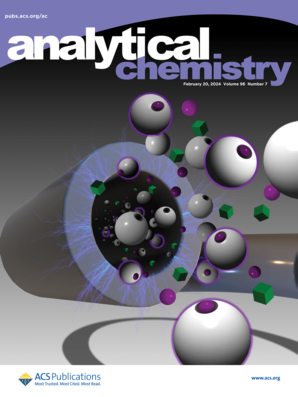One-Step Labeling Strategy for the Profiling of Multiple Types of Protein Glycosylation
IF 6.7
1区 化学
Q1 CHEMISTRY, ANALYTICAL
引用次数: 0
Abstract
Protein glycosylation, classified into N-glycosylation and O-glycosylation, is the most prevalent and complex protein post-translational modification. Bioorthogonal chemistry reactions combining the biotin–streptavidin interaction system are the most commonly used for investigating protein glycosylation. In this study, a one-step enzymatic labeling strategy for the simultaneous and global profiling of multiple types of protein glycosylation was developed. A “one-step probe” directly carrying the enrichment support poly(N-isopropylacrylamide) (PNIPAM) was designed and synthesized. Although the designed probe carried a large enrichment group (the number-average molecular weight of PNIPAM was up to 10,000 Da), it was well accepted by the two substrate-specific sialyltransferases to label N-glycopeptides and O-glycopeptides. PNIPAM is a temperature-sensitive polymer. When the temperature was below the lower critical solution temperature, PNIPAM was water-soluble and precipitated when it was above the lower critical solution temperature. The advantage of this property was that the labeled glycopeptides were enriched from complex biological samples by simply changing the temperature without the need for additional enrichment resins. Following enzymatic and ultraviolet-light-mediated cleavage, the labeled N-glycopeptide, core-fucosylated glycopeptide, and truncated mucin-type O-glycopeptides (Tn, STn, T, and ST antigens) were released sequentially for glycosylation profiling via mass spectrometry. This work provides an effective strategy to significantly reduce enrichment costs for profiling multiple glycosylation types.

求助全文
约1分钟内获得全文
求助全文
来源期刊

Analytical Chemistry
化学-分析化学
CiteScore
12.10
自引率
12.20%
发文量
1949
审稿时长
1.4 months
期刊介绍:
Analytical Chemistry, a peer-reviewed research journal, focuses on disseminating new and original knowledge across all branches of analytical chemistry. Fundamental articles may explore general principles of chemical measurement science and need not directly address existing or potential analytical methodology. They can be entirely theoretical or report experimental results. Contributions may cover various phases of analytical operations, including sampling, bioanalysis, electrochemistry, mass spectrometry, microscale and nanoscale systems, environmental analysis, separations, spectroscopy, chemical reactions and selectivity, instrumentation, imaging, surface analysis, and data processing. Papers discussing known analytical methods should present a significant, original application of the method, a notable improvement, or results on an important analyte.
 求助内容:
求助内容: 应助结果提醒方式:
应助结果提醒方式:


